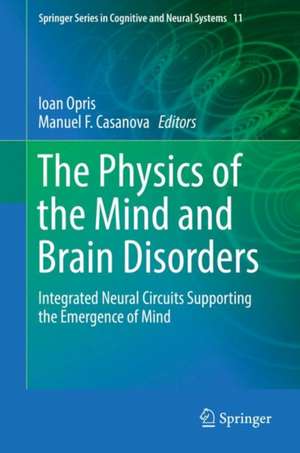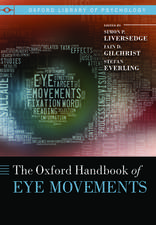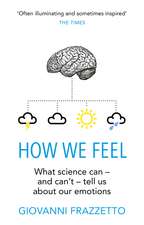The Physics of the Mind and Brain Disorders: Integrated Neural Circuits Supporting the Emergence of Mind: Springer Series in Cognitive and Neural Systems, cartea 11
Editat de Ioan Opris, Manuel F. Casanovaen Limba Engleză Hardback – 15 dec 2017
| Toate formatele și edițiile | Preț | Express |
|---|---|---|
| Paperback (1) | 1732.09 lei 38-44 zile | |
| Springer International Publishing – 30 aug 2018 | 1732.09 lei 38-44 zile | |
| Hardback (1) | 1752.71 lei 38-44 zile | |
| Springer International Publishing – 15 dec 2017 | 1752.71 lei 38-44 zile |
Preț: 1752.71 lei
Preț vechi: 2306.20 lei
-24% Nou
Puncte Express: 2629
Preț estimativ în valută:
335.49€ • 364.54$ • 281.99£
335.49€ • 364.54$ • 281.99£
Carte tipărită la comandă
Livrare economică 17-23 aprilie
Preluare comenzi: 021 569.72.76
Specificații
ISBN-13: 9783319296722
ISBN-10: 3319296728
Pagini: 793
Ilustrații: XVI, 793 p. 181 illus. in color.
Dimensiuni: 155 x 235 mm
Greutate: 1.45 kg
Ediția:1st ed. 2017
Editura: Springer International Publishing
Colecția Springer
Seria Springer Series in Cognitive and Neural Systems
Locul publicării:Cham, Switzerland
ISBN-10: 3319296728
Pagini: 793
Ilustrații: XVI, 793 p. 181 illus. in color.
Dimensiuni: 155 x 235 mm
Greutate: 1.45 kg
Ediția:1st ed. 2017
Editura: Springer International Publishing
Colecția Springer
Seria Springer Series in Cognitive and Neural Systems
Locul publicării:Cham, Switzerland
Cuprins
Preface.- PART 0.-Chapter 1. What Makes the Human Brain Special: Key Features of Brain and Neocortex (J. H. Kaas, Suzana Herculano-Houzel) .- Chapter 2. Introduction: From Neurons to the Mind (A. I. Popescu, I. Opris).- PART I.- Chapter 3. Systems Theory, Emergent Properties, and the Organization of the Central Nervous System .- (M. F. Casanova, I. Opris, E. Sokhadze, E. L. Casanova).- Chapter 4. Integrated Neural Circuits Supporting the Emergence of Mind (I. Opris, M. F. Casanova, M. A. Lebedev, A. I. Popescu).- Chapter 5. The Hierarchical Circuit for Executive Control of Movement (I. Opris and B. R. Noga).- Chapter 6. Symmetry and Noether Theorem for Brain Microcircuits (L. Bilteanu, M. F. Casanova, I. Opris).- Chapter 7. Locomotion and Symmetry Breaking in the Brain (B. R. Noga, I. Opris).- Chapter 8. Perturbation of Symmetry Breaking in Cognitive Disorders (I. Opris, B. R. Noga, M. F. Casanova).- Chapter 9. Gauge Fields in the Central Nervous System (A. Tozzi, B. Sengupta, J. F. Peters, K. Friston).- Chapter 10. Brain and Nonlinear Dynamics: Slow-wave Sleep Regulates to the Edge of Chaos (D. A. Steyn-Ross and Moira L. Steyn-Ross).- Chapter 11. Slow Oscillation in Prefrontal Cortex Underlying Local Computations and Large-Scale Interactions (S. Fujisawa) .- Chapter 12. Memory as Integration and Selection Processes over Space and Time in Temporal Cortical Microcircuits (M. Takeda).- Chapter 13. Holographic Memory: a Novel Model of Information Processing by Neuronal Microcircuits (A. Redozubov).- Chapter 14. Factors Influencing Opposing Effects of Emotion on Cognition: A Review of Evidence from Research on Perception and Memory (F. Dolcos, Y. Katsumi, E. Denkova, S. Dolcos).- PART II.- Chapter 15. Neural Correlates of Normal and Impaired Consciousness (A. Cavanna).- Chapter 16. EEG assessment of Consciousness Rebooting from Coma (C-A. Șerban, A. Barborică, A-M. Roceanu, I-R. Mîndruță, J. Ciurea, A-M. Zăgrean, L. Zăgrean and M. Moldovan).- Chapter 17. Role of Feed-Forward Inhibition in Neocortical Information Processing: Implications for Neurological Disorders (O. V. Favorov, O. Kursun, M. Tommerdhal).- Chapter 18. Cortical Microstructures: Lateralization, Ageing and Disruption across the Lifespan S. A. Chance.- Chapter 19. Building Elements of the Adaptive and Pathological Pain Neural Networks Maria-Luiza Flonta.- Chapter 20. Connectomics in Patients with Temporal Lobe Epilepsy (C. Donos, A. Barborică, I-R. Mîndruţă, M. Maliia, I. Popa, J. Ciurea).- PART III.- Chapter 21. Grid cells-From Data Acquisition to Hardware Implementation: a Model for Connectome-Oriented Neuroscience (D. Deca).- Chapter 22. Multipotentiality of the Brain to be Revisited Repeatedly (Y. Sakurai, T. Ohnuki, R. Shiroshita, Y. Sakaguchi, K. Shiotani, and C. Jung Lee).- Chapter 23. Characterization of Complex Brain Functions with Sparse Nonlinear Dynamical Modeling (D. Song and T. Berger).- Chapter 24. Controlling Attention with Neurofeedback (M. Ordikhani-Seyedlar, M. A. Lebedev).- Chapter 25. Towards a Visual Story Network Using Multiple Views for Object Recognition at Different Levels of Spatiotemporal Context (M. Leordeanu, R. Sukthankar).- PART IV.- Chapter 26. Pharmacology of the Mind (J. Tsou).- Chapter 27. Genetics of the Mind and Brain Disorders (T. Popovitchenko and M.-R. Rasin.- Chapter 28. The Spiritual Brain: Science and Religious Experience (A. Newberg).- Chapter 29. The Neurobiology of Moral Decision-Making, Embodied Cognition and the Case of Tolerance (Diana Stanciu).- Chapter 30. Insights into the Animal’s Mind (G. Predoi, I. Raus, F. Bărbuceanu, I. Opris ).- PART V.- Chapter 31. Blood Brain Barrier and the Mind (Ana-Maria Zăgrean, B. Ianosi, C. Sonea, I. Opris, L. Zăgrean).- Chapter 32. Application of a Conceptual Nanomedical Vascular Cartographic Scanning Nano-Device (VCSN) to the Mapping of the Human Brain: Survey of Human Brain Function and Cognitive Implications (Angela Domschke and F. Bohm).-Chapter 33. A Unified Physical Theory for CSF Circulation, Cooling and Cleaning of the Brain, Sleep, and Head Injuries in Degenerative Cognitive Disorders (I. Cherian and Margarita Beltran).- Chapter 34. Mind the Reward: Nutrition vs. Addiction (C. Sonea, A. L. Opris, M. F. Casanova, M. V. Constantinescu, I. Opris). Index.
Textul de pe ultima copertă
This book covers recent advances in the understanding of brain structure, function and disorders based on the fundamental principles of physics. It covers a broad range of physical phenomena occurring in the brain circuits for perception, cognition, emotion and action, representing the building blocks of the mind. It provides novel insights into the devastating brain disorders of the mind such as schizophrenia, dementia, autism, aging or addictions, as well as into the new devices for brain repair. The book is aimed at basic researchers in the fields of neuroscience, physics, biophysics and clinicians in the fields of neurology, neurosurgery, psychology, psychiatry.
Caracteristici
Unique approach to the brain functions through the laws of physics Renowned experts of various disciplines A book that summarizes our knowledge in the most challenging area of neuroscience The book provides a walking tour spanning introspection, behaviourism, the cognitive revolution to recent advances in neuroimaging and electrophysiology Summarizes a new discipline in the making, the science of the mind




























